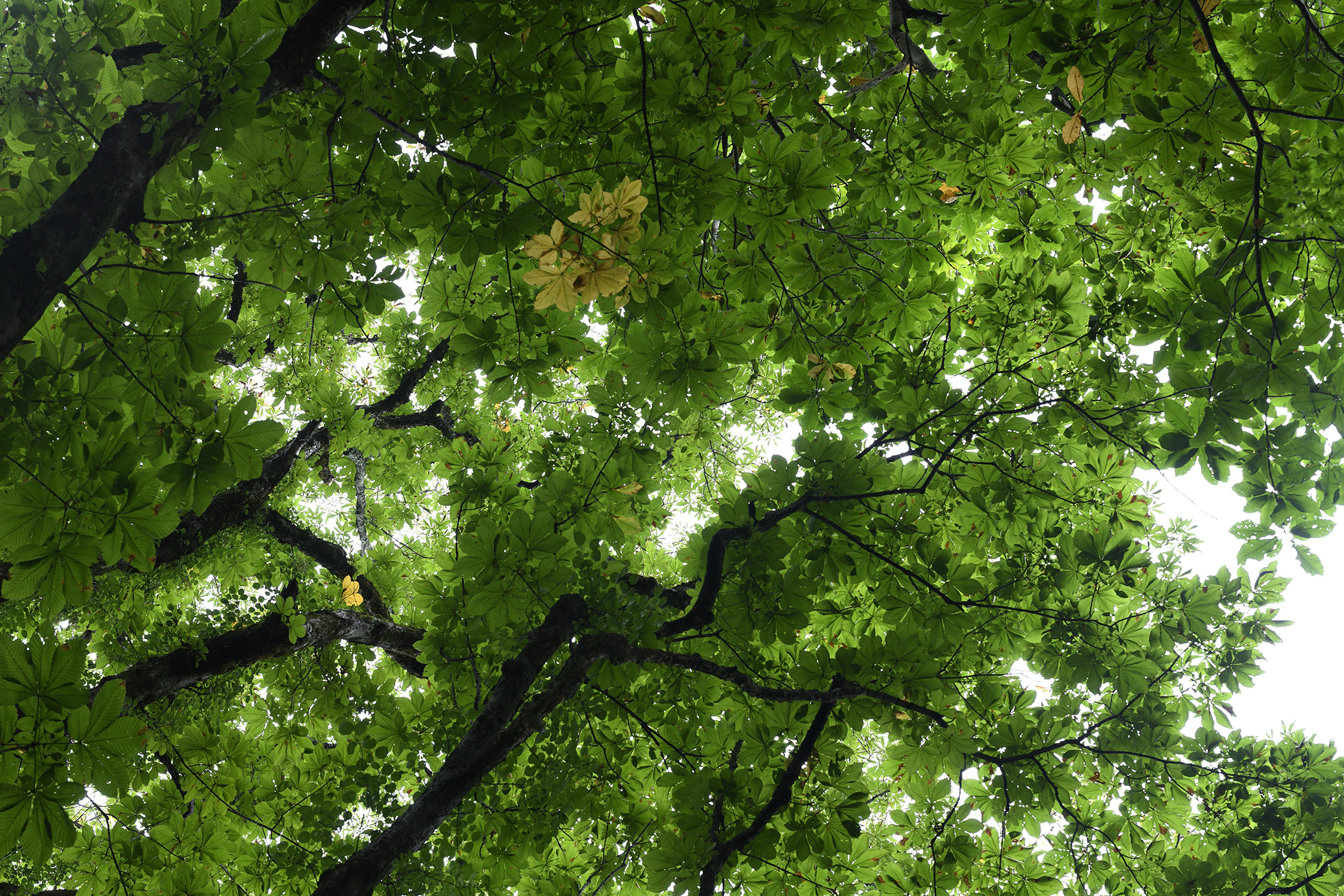 Nao Nakai
Nao Nakai2021.12.03
Story#PeasefulWaterGeography
New Greenpia Tsunan — a sustainable hotel
TextTaiki Honma
 Nao Nakai
Nao Nakai2021.12.03
Story#PeasefulWaterGeography
TextTaiki Honma
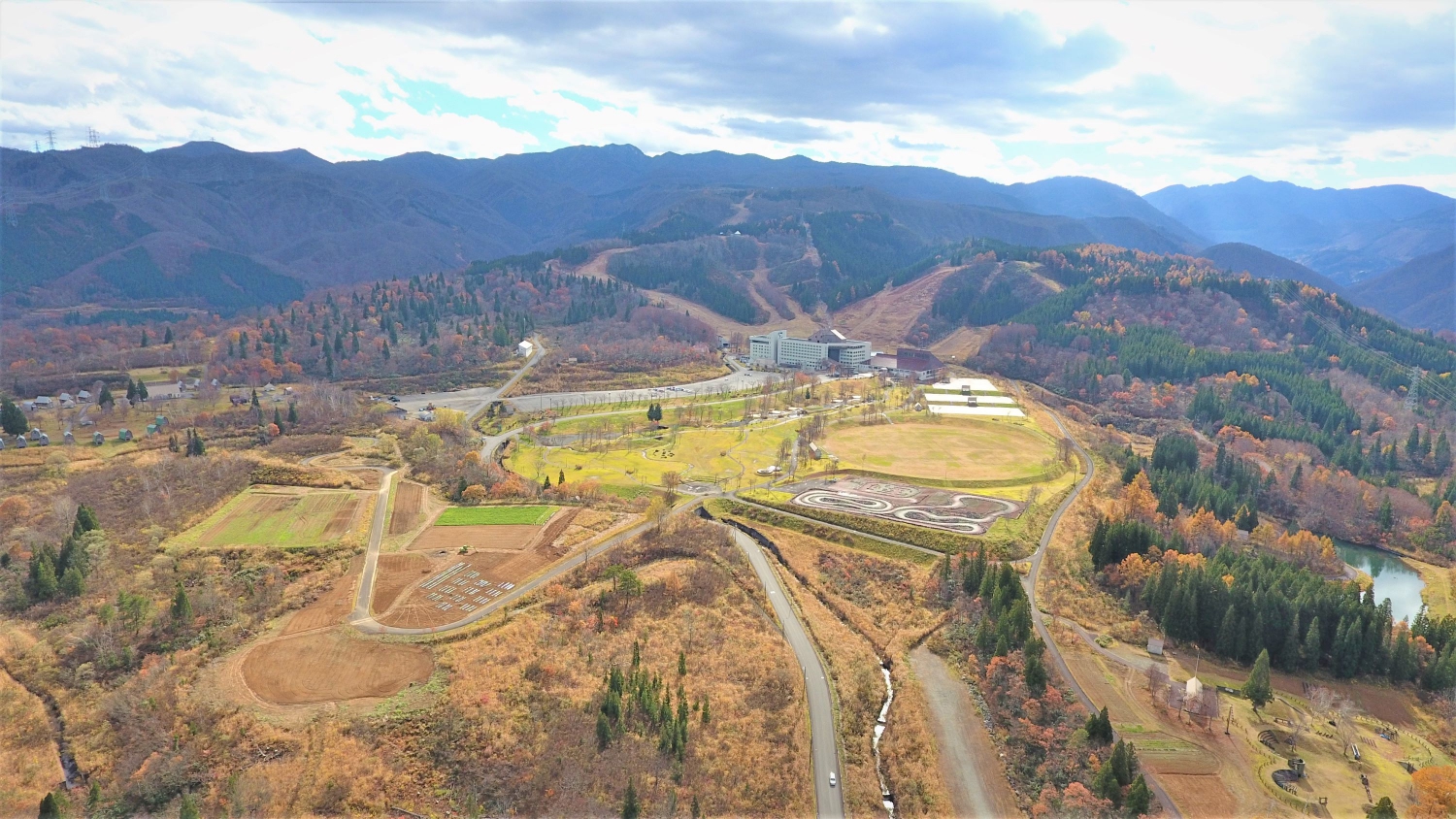
Follow Route 117 in the direction from Niigata to Nagano. Once you cross the Kiyotsu River and head left you soon find yourself heading up a steep, narrow road. You continue up a winding road through a quiet coniferous forest. Have you wandered onto the lower slopes of Mount Naeba? Just as you are having these thoughts, the view opens up and you find yourself among fields stretching out in front of you.
First time visitors to the area are often surprised by this sight. Among the river terraces of Tsunan which are said to have 9 or 11 levels, the largest is the Maibara area which is at an altitude of 500 meters. Through the middle of that space stretches a straight road, and in the distance you can see an impressive mountain range including Mount Naeba (2,145 meters.) On both sides of the road are orderly fields and it is an otherworldly sight, not so much a city in the sky, but a garden in the sky instead.
If you continue along that road, you go over Maibara, and reach the oldest level, Taniage, where your destination, the New Greenpia Tsunan finally comes into view.
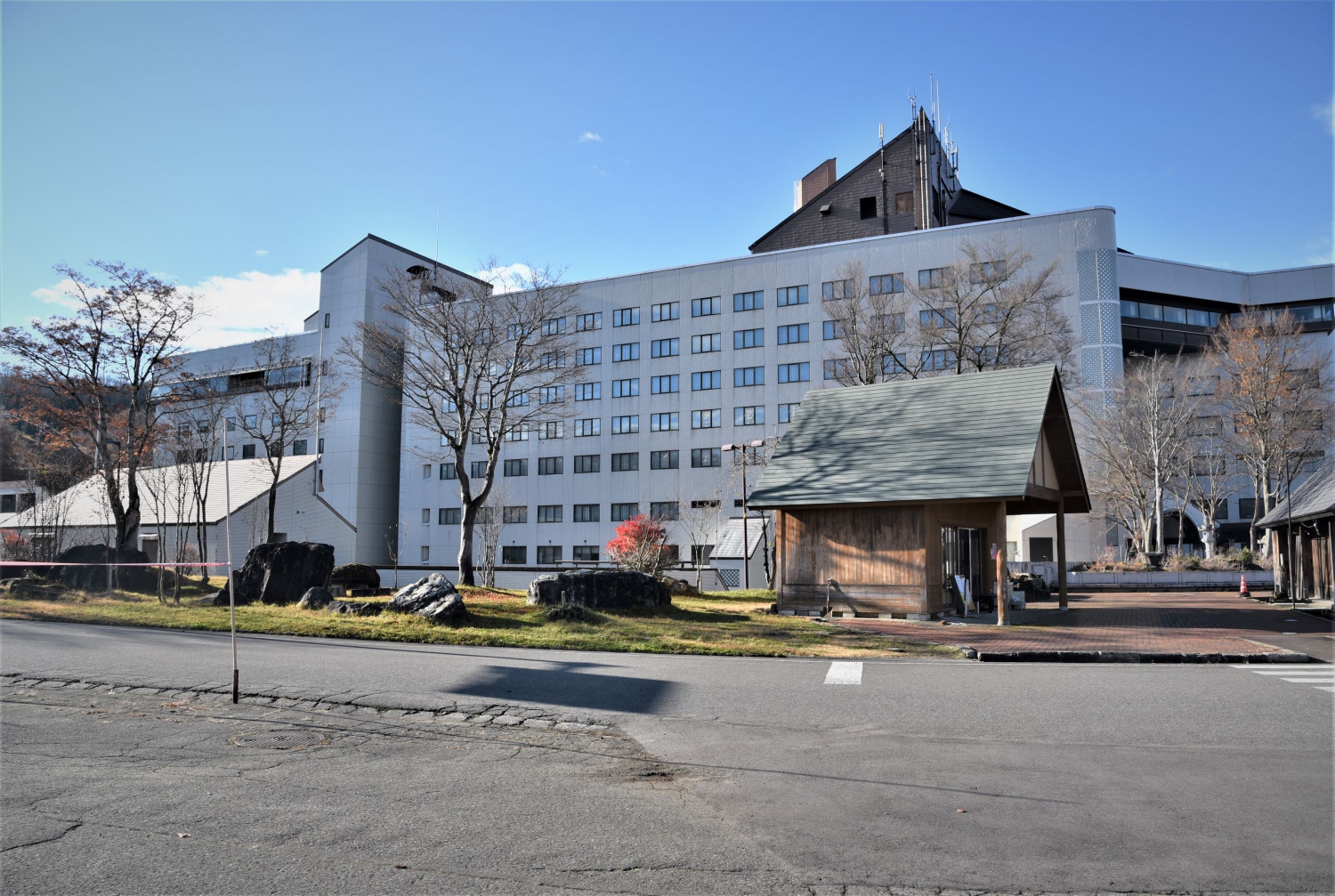
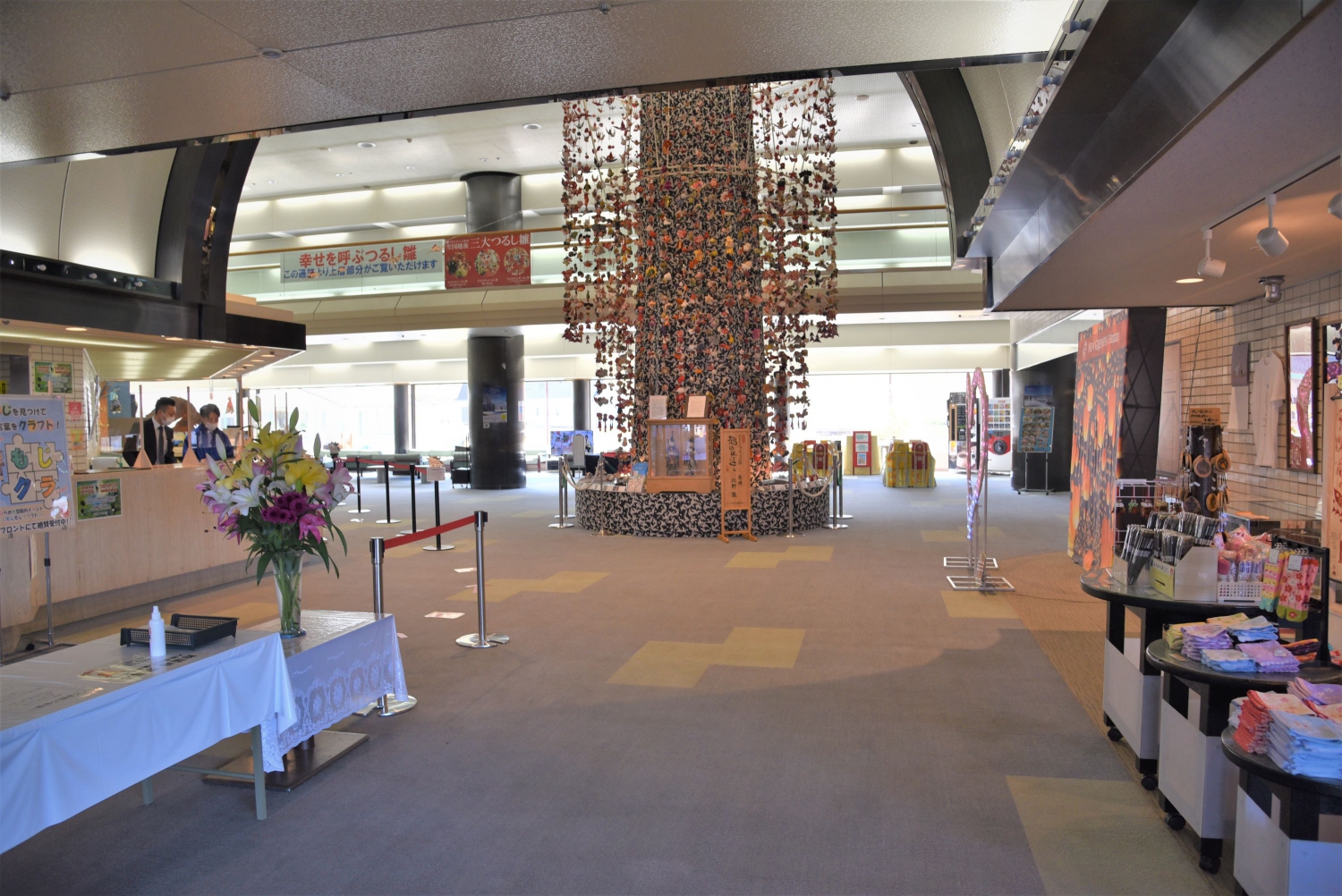
The hotel started operating on December 1st 1985. 35 years have passed already though the white, modern building doesn’t seem to have aged in that time. The main building and east wing have 146 rooms and can accommodate around 600 guests. There are a variety of baths and saunas, a warm water indoor pool, spacious banqueting hall and restaurant, as well as cafes and dining rooms. There are also other leisure facilities to enjoy such as shops, a game center, table tennis tables, bowling alley, and a sports hall.
The hotel itself is very spacious but it should also be noted that there are expansive grounds, as well as many outdoor facilities too. The whole property is about the size of 81 Tokyo Domes, covering around 3.79 square kilometers. The full list of attractions within the grounds includes a sports ground, ski resort, camping ground, mallet golf course, tennis courts, obstacle course, go-karting, fishing, beech forest, and nature walk.
Rather than just a place to stay, it is a complete amusement resort and large park.
This large facility in its beautiful natural setting up at 600 meters owes its existence to Kakuei Tanaka’s idea of revitalizing Japan through land development. In 1975, the Pension Welfare Corporation, which at the time was under the jurisdiction of the Ministry of Health and Welfare, launched the Green Pia project, which was funded by the pension fund. With large scale investment from the pension fund, sizable recreation facilities were to be built in 13 locations across Japan.
Greenpia Tsunan was one of these, but after the bursting of the economic bubble and changes to the structure of society such as the low birthrate and aging population, many of these facilities ran into problems. At the same time due to issues within the pension fund and structural reforms the then Prime Minister, Junichiro Koizumi decided to shut down the Greenpia project in 2005. Each facility was then handed off to the local governments for that area.
Many of the locals in the Tsunan area wanted to put this facility to good use so it was given a new lease of life as a public facility under private management. As a result, in October 2005 the Tsunan Kogen Development Company was given the charter by Tsunan town to operate the New Greenpia Tsunan.
As the times have changed, so has the significance of this facility. The manager of the Tsunan Kogen Development Company, Mr. Akira Higuchi has said that, “I would like this to be a place where you can experience and come into contact with the nature of Tsunan, not just an accommodation and amusement resort. From an environmental perspective I hope it will give us the chance to re-evaluate how we live and interact with nature.”
The luxurious resorts that were commonplace in the tourism industry during the periods of high economic growth and the bubble years are a thing of the past. Visitors can explore a way of life that is in harmony with the environment while coming into contact with the local nature which is one of this area’s great blessings. The facility is undergoing major changes as a place for individuals to experience a sustainable way of life and a different way of thinking.
New Greenpia Tsunan is the perfect destination to experience and enhance your understanding of the nature and land around Tsunan. In July 2014 the area from Sakae village in Nagano to where the Nakatsu and Shikumi Rivers flow into the Shinano River was designated as the Naeba Sanroku Geopark. 2 million years ago this area used to be at the bottom of the ocean. At that time a rift over 600 meters deep called the Fossa Magna ran north/south down the middle of the Japanese archipelago splitting it into two islands, east and west. That trench was filled with ocean. About 2 million years ago this began to rise due to severe plate movement. The bottom of that trench now forms the highest parts of Japan such as Mount Fuji and the Southern Alps. At that time the shape of the Japan that we know was formed.
The mountain range that was raised up by those strong movements was eroded by the flows of the Shinano River and the rivers that flow into it, the Nakatsu and the Kiyotsu and a large amount of debris was spread out in an alluvial fan. The shape of the alluvial fan was altered by the erosion of the river and the uplift of the earth, and the 10 stepped river terrace which is the unique topography of Tsunan was formed.
In this area it is not unusual for over 3 meters of snow to fall in winter, even the highlands are blessed with a reliable water supply, and for 10,000 years the Jomon people chose to live in this area. Many Jomon era sites have been uncovered on the river terraces and large quantities of the things they used in their daily lives, such as the amazing flame-shaped pottery have been found.
Since ancient times there have been people who have faced up to the dynamism of nature, and learned how to thrive in coexistence with it. The Jomon culture which is said to have lasted over 10,000 years is an early example of a sustainable way of life that we may have lost touch with. This long shadow of history still spreads over the river terraces of Tsunan.
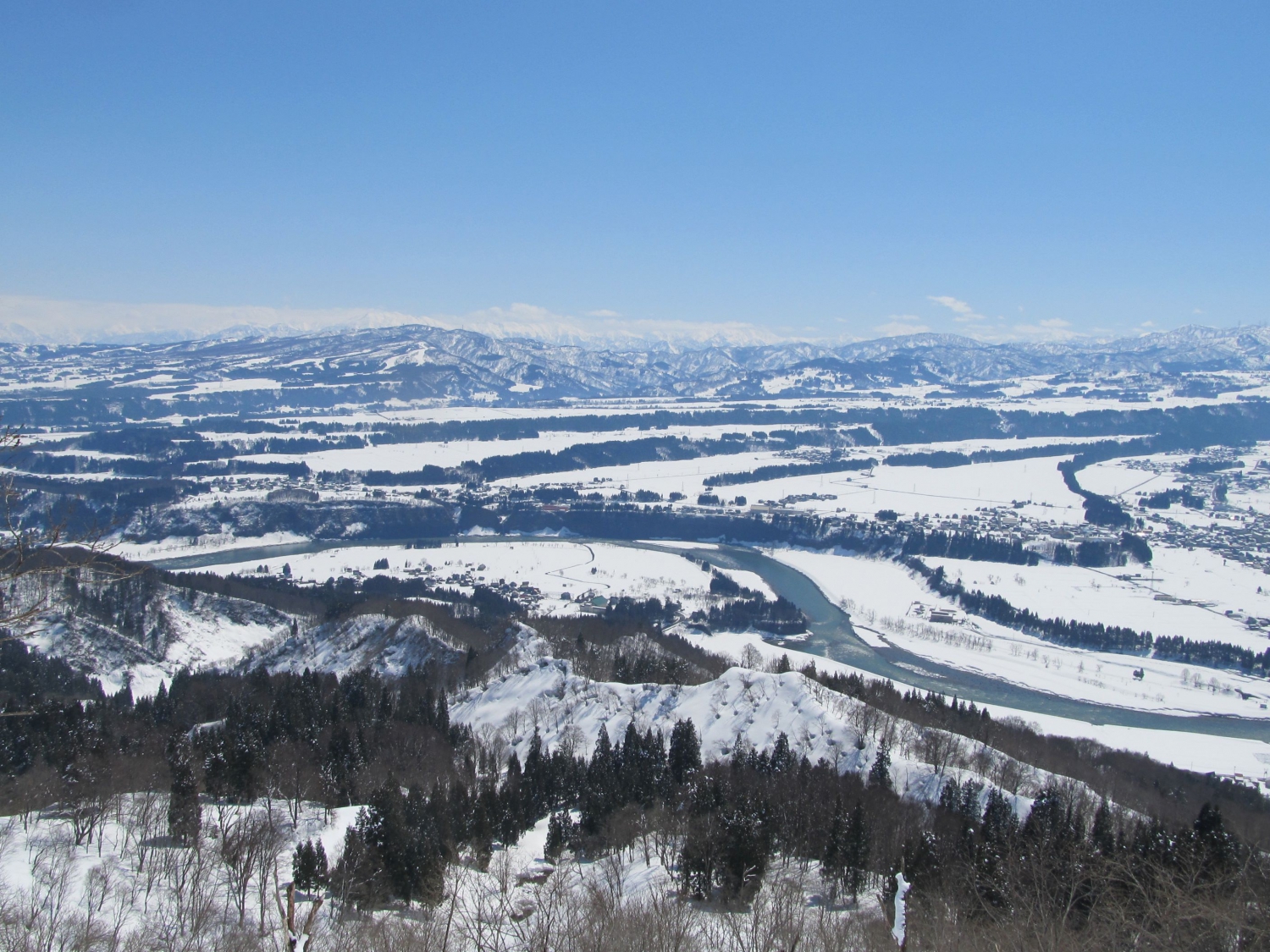
New Greenpia Tsunan is located in the middle of the Naeba Sanroku Geopark. The building on the top level of the river terraces conducts a fantastic view over the other terraces and the mountains of Tsunan. About 5 minutes up the road by car is the New Greenpia Tsunan Observatory. This is one of the main viewing points for the Geopark and is also known as the Valley Observatory. From here, lined up on the far bank of the Nakatsu River you can see the columnar joint formations on the cliffs in Midama Park. This is one of the geosites in the geopark and is commonly known as “Ishi-otoshi”. It consists of rocks in the shape of pillars that have long narrow cracks in them that were formed by the lava as it cooled. The pillars were exposed by erosion and now make for a spectacular sight that is often referred to as the ‘Grand Canyon of Japan’.
If you look to the right you can see the Akazawa plateau where Ryugakubo is located, and on the other side of the Shinano River you can enjoy the panoramic vista of the mountain range in the direction of Matsunoyama. Over to the left, on a clear day you can catch a glimpse of the summit of Mount Myoko in the distance.
Ms. Masako Ishihara, vice president and proprietress of the New Greenpia Tsunan explains, “Around the observatory area it is possible to enjoy a trekking course that brings you into contact with the trees and plants of the highland area. It draws a lot of students from both within and outside the prefecture. We offer a program in collaboration with the guides and curators from the Geopark that explains the living nature and geology of this location.”
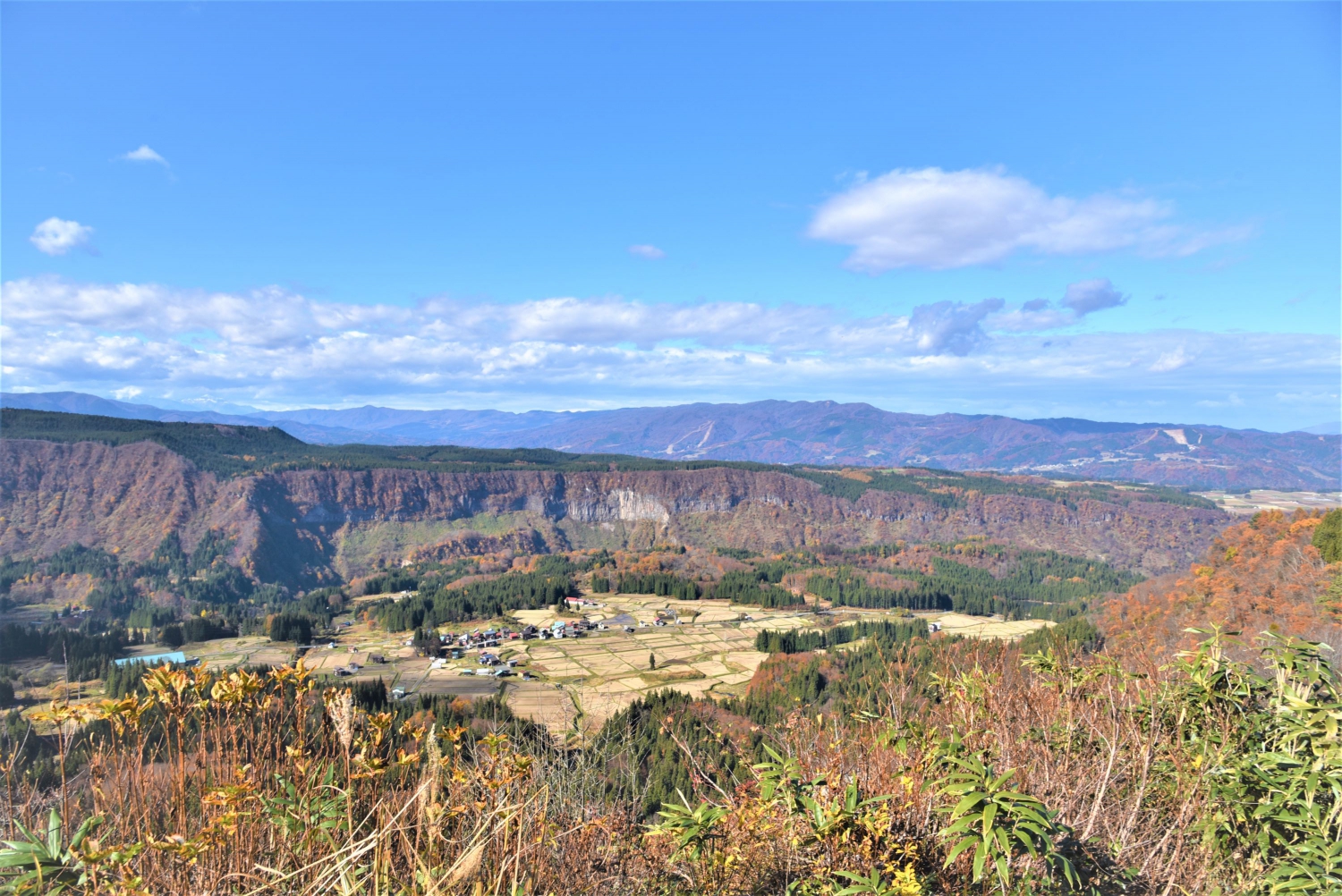
If you walk through Central Park you will come across small cherry blossom trees adorned with plaques lined up along the side of a small stream. Mr. Higuchi who is mentioned above explains that, “This is from a tree-planting project that started about 6 years ago. Every May there is the Tsunan Cherry Blossom Festival, and young cherry blossom trees that were donated by the Japanese Sakura Association are planted.”
Around five thousand cherry trees have already been planted. If this continues to get bigger this area will soon be very well-known for its cherry blossoms in spring.
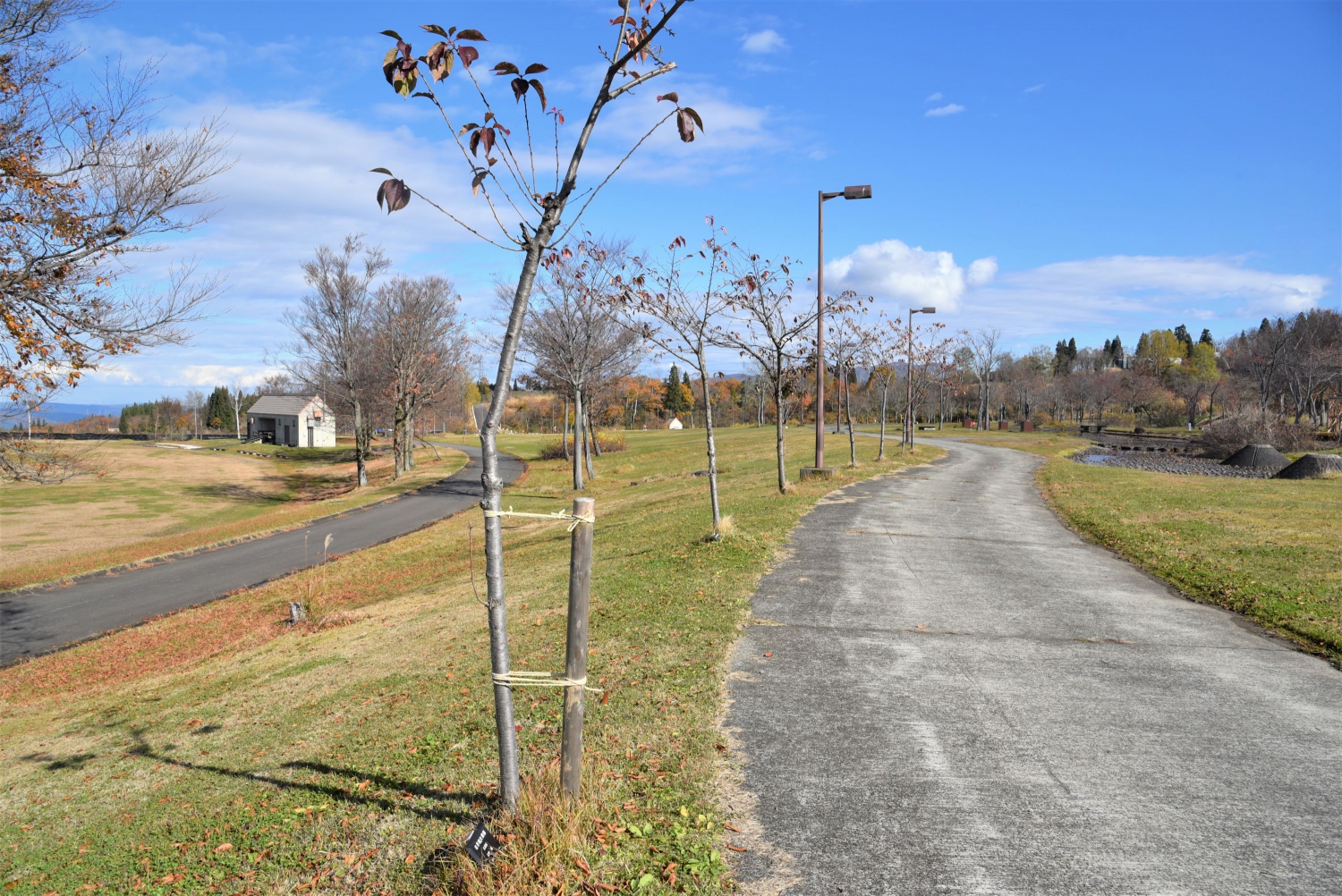
There is now a glamping site that was recently opened close to the cherry trees. Mr. Hiroki Nakajima, the head of sales was instrumental in the development.
“In April 2021 we launched a crowdfunding campaign in order to attract investment. A large number of people pledged their support and we managed to raise over four million yen.”
Work started quickly but immediately ran into problems. Due to the effects of the Coronavirus pandemic it was difficult to procure timber, and progress was severely threatened. “So we went to talk with the Tsunan Forestry Association, and it was decided to process and use trees that were felled in and around Tsunan,” said Mr. Higuchi. Mr. Nakajima and his staff then processed all the timber and built five glamping units themselves.
Mr. Nakajima laughs as he explains, “I never imagined that we would have to do all that, but it was a great experience.” This facility is a true use of Tsunan’s nature. It also reflects the commitment of the hotel to sustainability and existing in harmony with the natural environment.
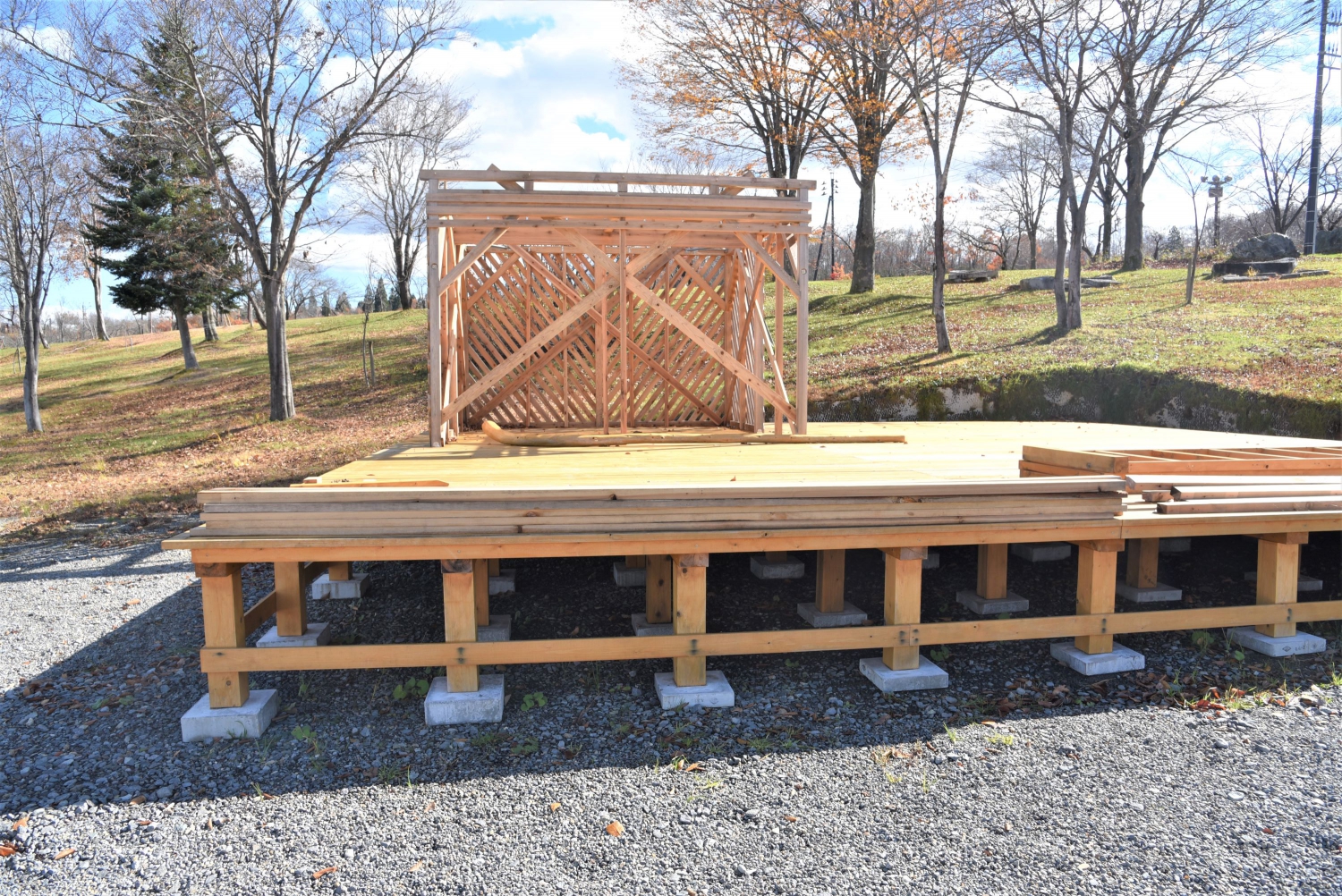
All the water used at the New Greenpia Tsunan comes exclusively from wells and springs that are found on the premises. Ms. Ishibashi says, “The water in Tsunan is well-known for being delicious, but the water here is even more highly regarded. We have full confidence in that and even all the food cooked with it benefits.”
The snows that fall over Naeba Sanroku in winter enter the water supply after having passed through lava from the eruptions of Mount Naeba, and through the loam layer to become very pure ground water. It doesn’t come into contact with outside air so has no pollutants and is just pure. It is no exaggeration to say that the New Greenpia Tsunan has the best water out of all the hotels in Japan as they obtain direct from source as soon as it emerges.
It is not just the drinking water, but all the water in the whole facility that comes from natural sources with no reliance at all on mains supply, and there can’t be many places that can boast of that. It is only possible thanks to the nature of Tsunan and its abundant water supply.
Recently they have been taking advantage of their spacious grounds and abundant water supply to grow agricultural produce. “Carrots from under the snow” from Tsunan which are a famous product of the area have been one of these. Carrots are left under the deep snow through the winter. In order to survive the cold the plant cells replace glycol with sugar which gives them their characteristic sweetness.
Mr. Masaichi Sato of Naeba Geopark explains, “If the plant cells are exposed to temperatures under 0℃ they freeze and are destroyed. Under the snow in Tsunan is moist so doesn’t drop below freezing so it is comparatively ‘warm’. This would be difficult to achieve in the colder climes further north with its powder snow. This is something that can only be achieved in this region with its snow and climate.”
These special carrots are not only used in the food served at the hotel, but are also available to order from their online shop. The hotel is also growing daikon radish, Chinese cabbage, sweet potatoes and other kinds of summer vegetables.
“The younger staff here are playing a central role in the farming,” says Mr. Nakajima. One of the unusual sights at this hotel is that you are equally likely to find staff like Mr. Nakajima greeting you in smart attire at reception at one moment, and then working the fields in overalls and gumboots the next. From March to mid-April they also offer the chance for guests to help dig for carrots from under the snow.
Out in this magnificent natural environment, they strive to do as much as they can to understand its powers and blessings, while trying to make good use of them. New Greenpia Tsunan really stands apart from other hotels as it takes inspiration from the Jomon way of living, and aims to be a place where you can experience true sustainability.
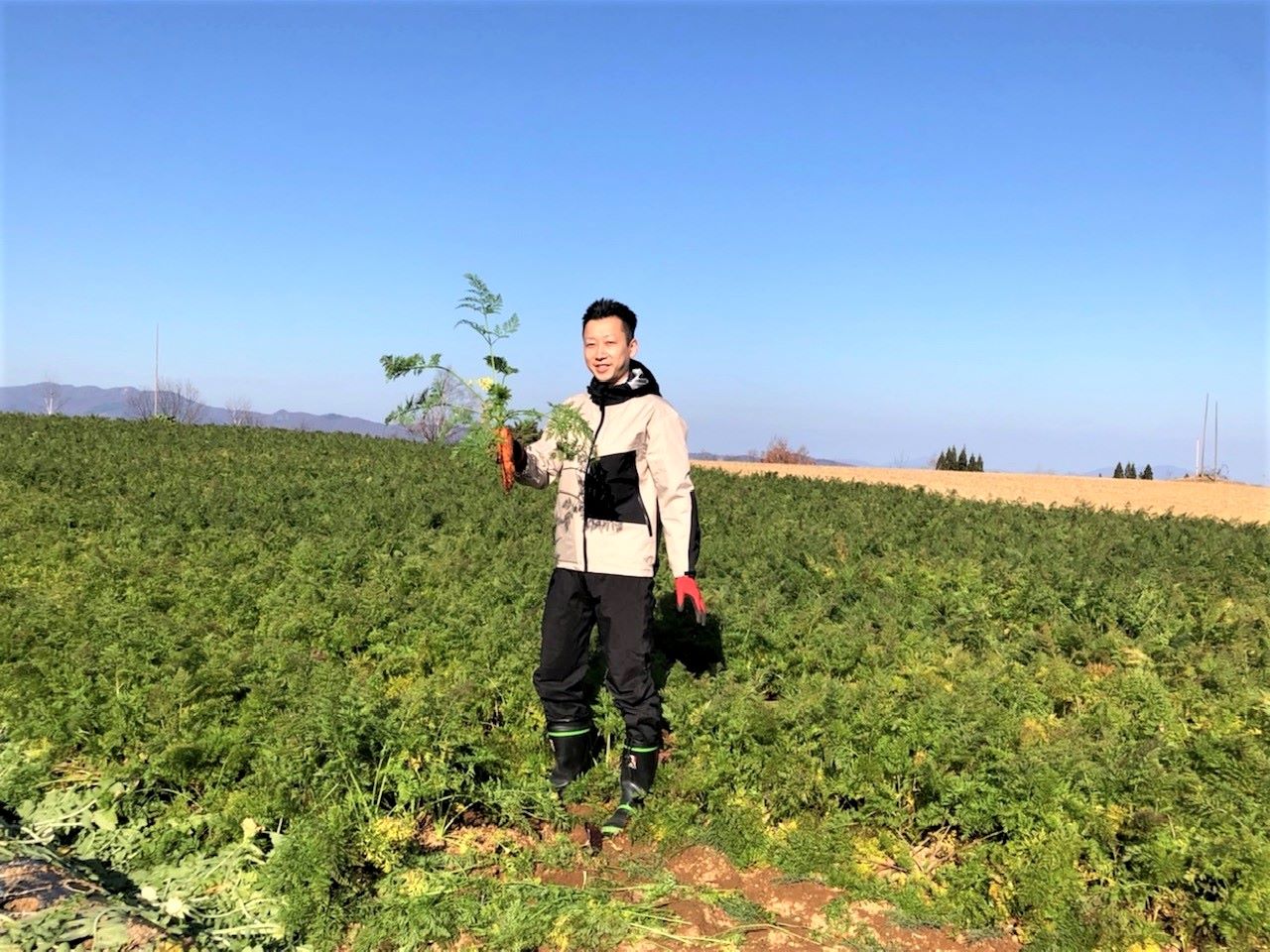
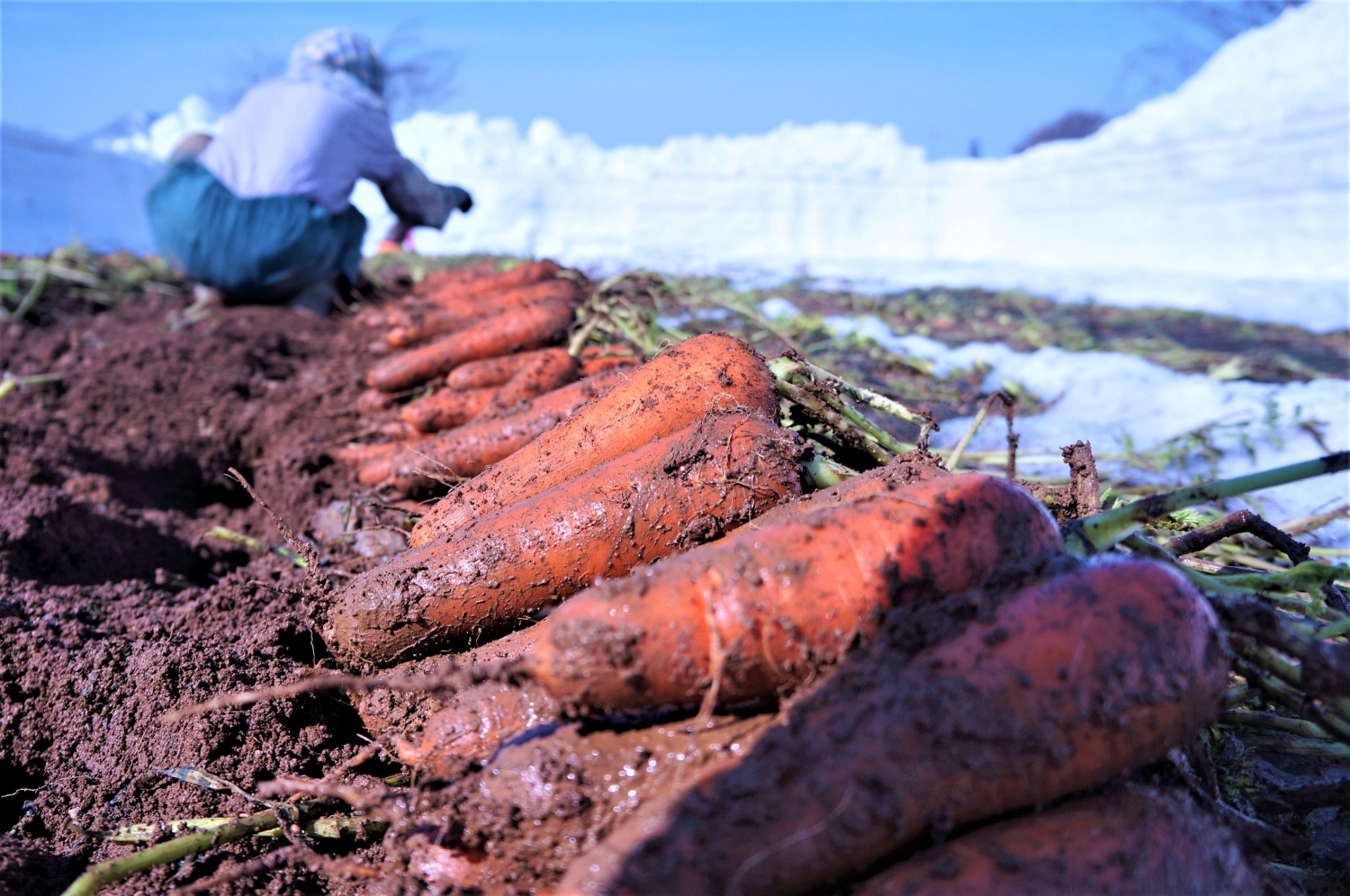
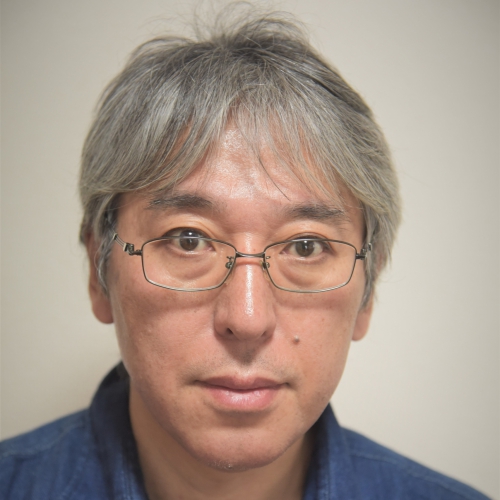
TextTaiki Honma
Tsunan Midama Park
This is one of the best viewing points in Tsunan to observe the columnar jo…
| 住所 | Midama shuraku, Tsunan-machi, Nakauonuma-gun, Niigata, 949-8313 |
River Observatory (River Terrace and Shinano River Observatory)
The River Observatory sits at an altitude of 450m and from there you can lo…
| 住所 | Tomaru, Tsunan-machi, Nakauonuma-gun, Niigata, 939-8206 |
ForestGeography
Walk Amid Spectacular Views of the Naeba Foothills and Akiyama-go!
TextTaiki Honma
AgricultureWaterSnow
The Story of Tsunan’s Water
TextMatt Klampert
PeasefulForestGeography
A Look into the Calming and Peaceful Forests of Tsunan
TextMatt Klampert
AgricultureWaterGeography
The Water of Ryugakubo──The Wonder of Nature and the Deity
TextTaiki Honma
©2025 Tourism Tsunan